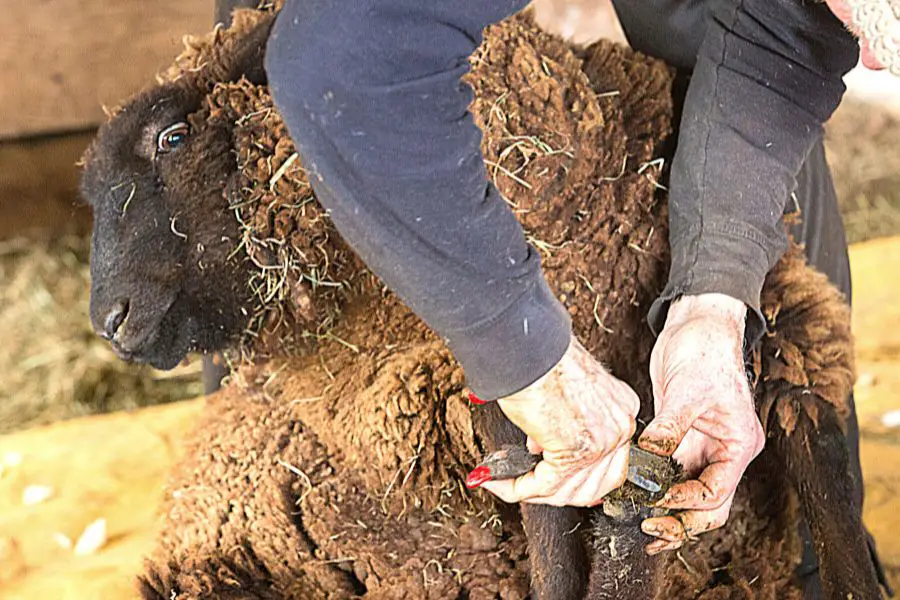Did you know that foot problems account for two-thirds of antibiotic use in sheep? Yet, despite its significance, foot health is often overlooked in sheep. A lame sheep cannot graze adequately and becomes stressed if it is left behind when the flock moves off. A sheep unable to walk to the water trough soon becomes dehydrated. Wise sheep farmers educate themselves on the causes, prevention, and treatment of sheep foot problems.
Wet weather predisposes sheep to conditions such as foot rot and scald. Bacteria causes Contagious Ovine Digital Dermatitis and abscesses. Excessive trimming causes toe granulomas, and shelly hoof arises from untrimmed hooves. Poor nutrition and hoof neglect worsen sheep foot problems.
As a responsible sheep owner, it's important to anticipate potential foot problems before they occur. Timely intervention can prevent or limit many sheep foot problems from occurring.
Foot Scald In Sheep

Foot scald is an infection that is more common in moist conditions and, as a result, is seen more often in the rainy season. It is caused by Fusobacterium necrophorum, which proliferates in damp weather.
The bacteria invade the foot, and the skin between the sheep's toes or claws becomes infected. The interdigital skin is red and may ooze a whitish, grey fluid. There is no smell, but the area is painful, and the sheep may be lame.
Scald is also known as strip or Ovine Interdigital Dermatitis (OID). The infection occurs because the sheep's continuously wet feet result in softened skin, easily penetrated by the bacteria in the soil.
Many sheep in a herd may get scald at the same time. It can be prevented by moving sheep from soggy pastures or, if this is not possible, keeping them in a dry yard or housing them in a dry barn each night.
Straw should not be used as barn bedding as it facilitates the growth of Fusobacterium necrophorum. It would be better to use absorbent bedding such as wood shavings.
Sheep can be treated for scald by using oxytetracycline or iodine spray on the affected area. A foot bath may be a more manageable treatment if numerous sheep have scald. The foot bath should contain a ten percent zinc sulfate or copper sulfate solution.
Some farmers use a three percent formalin solution, but formalin may harden the top skin layers, leaving infection in the underlying tissues. Stronger solutions of formalin cause severe skin irritation and should not be used.
The sheep should stand in the footbath for ten to fifteen minutes. The footbath and spray treatments should be repeated daily for seven to ten days.
It is vital that the sheep stand in a clean, dry area after the foot bath.
Foot Rot In Sheep
Foot rot is preceded by scald. Fusobacterium necrophorum compromises the integrity of the skin, allowing another bacteria to penetrate the tissues. Dichelobacter nodosus is present in contaminated soil and causes foot rot. It thrives in warm moist conditions. Sheep with permanently wet feet are at risk of developing foot rot.
The interdigital tissue is moist, red, and becomes swollen. Tissue erodes between the toe sole and the hard outer horn. The outer wall of the hoof separates from the sole due to bacterial enzymes that digest and liquefy tissue proteins.
Dirt and debris collect in the space between the sole and the wall. The broken-down foot tissues and exudate from inflammation result in a distinctive foul odor.
Foot rot is extremely painful. Sheep with only one hoof affected will not weight-bear on that leg. If both front feet are affected, the sheep will kneel to graze and may try to walk on their knees, causing further damage.
To add to the miserable state of sheep with foot rot, flies may lay their eggs in the wounds. The larvae hatch in the feet and begin eating the foot tissue. This condition is commonly known as a fly strike.
Foot rot prevention and cure is similar to scald, consisting of sprays and foot baths. The treatment may need to be repeated twice daily to be effective.
Infected sheep should be isolated in dry fields to prevent infection of the entire flock. The flock should be moved to a 'clean' pasture where sheep have not grazed for at least fourteen days.
Long-acting tetracycline injections may be used in severe cases of foot rot. Sheep can be vaccinated against foot rot, and it is worth investing in this vaccination program if foot rot is a repeated problem in the flock.
Rotational grazing can help prevent foot rot which occurs more commonly in the rainy season or as snow and ice thaws.
The sheep's foot may deform as it grows, necessitating corrective trimming.
Contagious Ovine Digital Dermatitis
Contagious Ovine Digital Dermatitis (CODD) was not clearly understood until recently. A 2021 study showed that 83.9% of CODD cases were preceded by scald and foot rot. In addition to Fusobacterium necrophorum and Dichelobacter nodosus, three other pathogens were identified. These were Treponema medium, Treponema pedis and Treponema phagedenis.
CODD is a severe, painful condition usually involving one digit of a sheep's foot. The initial lesion occurs on the coronary band (junction of the skin and hoof wall). Then, the horn capsule detaches from the coronary band towards the toe, causing severe lameness.
Sheep with CODD lie down and do not graze, causing rapid weight loss and poor body condition.
Hair loss may be seen on the coronary band. There may be permanent damage to the foot, affecting the regrowth of the horn capsule.
In the 2021 study, it was found that two injections of long-acting amoxicillin forty-eight hours apart successfully cleared 91.7% of the pathogens involved in CODD. The dose rate used was 10mg/kg given by intramuscular injection.
Long-acting tetracycline, tilmicosin, and gamithromycin are alternative antibiotics that may be used. Studies to compare the effectiveness of the various antibiotics on CODD have not been done.
Foot baths containing lincomycin and tylosin have been used to treat sheep with CODD. The topical antibiotic footbaths were used in conjunction with systemic antibiotics.
The researchers in the study emphasized the importance of promptly treating scald and foot rot to prevent CODD development. In addition, some sheep may need to be culled if CODD severely damages the feet.
Foot Abscesses In Sheep
Foot abscesses can occur in sheep from minor injuries which become infected. For example, sheep receive foot injuries from sharp sticks and thorns as they move through the pasture. In addition, objects embedded in the sole and bruises from hard surfaces can cause foot abscesses.
Foot abscesses cause swelling and redness around the foot. The foot may feel hot when touched. The sheep will react to pressure on the sole if the abscess is located on the bottom of the foot. Generally, abscesses cause marked lameness.
They can be prevented to an extent by ensuring there are no sharp objects or wires in the fields. However, removing all objects that might injure the sheep is impossible, and abscesses will occur occasionally.
Hoof abscesses are usually well encapsulated, and systemic antibiotics are not often effective due to limited blood flow. However, applying a poultice and bandaging the foot for several days can be helpful for an abscess that has not yet burst.
The poultice softens the tissue allowing the pus to exit the foot. In some sheep, it may be necessary to lance the abscess or cut the sole of the foot to release the pus.
The abscess can be flushed, and antibiotic ointment can be inserted into the wound. However, it is essential to keep the foot clean until the abscess has healed.
Toe Granulomas In Sheep
Toe granulomas occur in sheep when the inner tissues grow from the sole horn like a red ball. Granulomas are proud flesh that develops in response to inflammation. The body attempts to isolate bacteria, fungi, and foreign objects by forming the granuloma.
The tissue bleeds easily and is very painful. The sheep is lame on that foot and often takes no weight on it.
Granulomas may develop in response to untreated foot rot or CODD. In addition, over-trimming a hoof can result in the growth of a granuloma, especially when the sensitive underlying tissue is cut during a trim.
Overuse of foot baths softens the sheep's feet, making them vulnerable to injury and potential toe granulomas.
Prevention includes good foot management and prompt treatment of foot issues. In addition, feet should only be cautiously trimmed when necessary.
Granulomas can be treated by tying them off with suture material or dental floss. This method cuts off the blood supply, and the growth dies.
Copper sulfate or a mix of copper sulfate and activated charcoal may be used to dry up the growth, reducing the size. The foot is usually bandaged to keep the copper sulfate in contact with the granuloma.
Antibiotics and antifungals may be used topically and systemically if an infection is a concern. However, Granulomas may regrow, and some farmers prefer to cull these sheep.
Shelly Hoof In Sheep
Shelly hoof is also sometimes called White Line Disease. The sole and the wall or horn of the hoof separate at the white line where they meet. Poor hoof maintenance and overly long hooves lead to the degeneration of the white line.
The space that opens at the white line becomes packed with dirt, mud, and manure. The hoof wall may flake or break off in large sections. Shelly hoof allows bacteria and fungi to enter the foot and cause a significant breakdown of the hoof. Abscesses may develop from infection.
Shelly hoof is more common in sheep with white hooves as they are often less robust than black hooves. In addition, wet, soggy ground conditions predispose sheep to shelly hoofs as the foot is softened by being permanently wet.
Sheep that have formalin foot baths can develop shelly hoof. Formalin may affect the hoof structures, making them vulnerable to white line disease. Poor nutrition can make hooves weak and prone to chipping and breaking.
Good hoof maintenance and trimming the hooves when necessary can prevent shelly hoof. Ensuring well-balanced nutrition and dry footing for sheep keep their feet in good condition and make them less likely to develop a shelly hoof.
Shelly hoof is treated by cutting off breaking sections and trimming the hoof appropriately. However, it may take several months to correct a hoof with white line disease.
Conclusion
Sheep foot problems can have various causes, but good housing, proper footing, and adequate nutrition can largely prevent them from occurring. However, in the event that foot problems do arise, timely intervention is crucial in limiting their severity and ensuring the health of your flock. By taking proactive measures and staying vigilant, you can help your sheep maintain healthy feet and overall well-being.
This is not a Veterinarian Advice
The Ideas and Strategies presented on this website and the information are based on our research and experience. These strategies are not intended to be a substitute for professional medical advice, diagnosis, or treatment. The information and/or documents contained on this website do not constitute veterinarian or medical advice. You should not disregard, or delay in obtaining, medical advice for any medical condition your livestock or pets may have.
